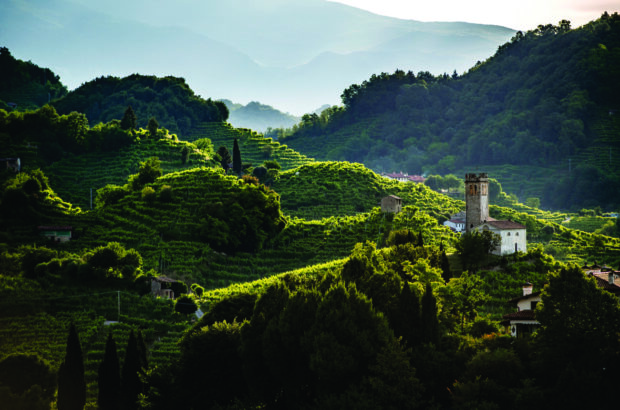Cucina povera – Italian peasant cooking – is the way people have been cooking in Italy for centuries. This is not just a unique approach to cooking and ingredients; it’s the highest expression of the Italian arte dell’arrangiarsi – the art of making do with what you’ve got. Tuscany’s cucina povera is in my blood. I was born in the Tuscan countryside and raised in a traditional tight-knit family, with a mother and grandmother who applied the principles of the cuisine to our everyday meals.
Traditional cucina povera dishes are immediately recognisable from some common traits: the use of humble ingredients, seasonal vegetables and simple cooking techniques, along with a healthy dose of imagination. It relies on basic, affordable ingredients that are available no matter where you live. Day-old bread and leftover pasta, rice and boiled meats are transformed with inventiveness into treats like fried arancine/arancini, spaghetti frittata, meatballs and beef stew with onions.
With their short lists of affordable ingredients and simple cooking techniques, cucina povera dishes easily fit into our modern lives, with a traditional yet contemporary focus on sustainability, budget and inclusiveness. Dishes are often vegetarian or vegan, and naturally gluten-free.
Meat is eaten only on rare occasions. Rather, the cuisine is centred around dishes made with fish or vegetables, and plant proteins such as chickpeas and fava beans, along with basic ingredients such as chestnuts, potatoes and pasta.
These ingredients may be simple, but when used the Italian way, you never feel like you are missing out.
Riso al nero recipe
The use of squid ink is common throughout the Mediterranean, from Venice to the coast of Tuscany, from Croatia to Sicily and on to Spain, with its traditional arroz negro. Squid ink is thick and intense, with a salty taste and a hint of iodine, and a brininess similar to that of oysters and sea urchins. Add a couple of squid ink sachets to risotto and you’ll have a showstopping dish.
Riso al nero, a Venetian dish, was taken all over the Mediterranean by Venetian merchants. Its striking appearance – pitch-black, thanks to the ink – makes it unforgettable. Its intense flavour reduces the need for other seasoning, so a small knob of butter and a pinch of salt are all that is necessary to finish the risotto.
Serves 4 as a first course
Ingredients
- 500g squid
- 80ml extra-virgin olive oil
- 1 clove garlic, finely minced
- fine sea salt
- red pepper flakes
- 120ml dry white wine
- 300g Carnaroli, Arborio or Vialone Nano rice
- 840ml hot fish stock or lightly salted hot water
- 2 tsp squid ink
- 30g unsalted butter
- 2 tbsp fresh flat-leaf parsley, finely chopped
Method
1. To clean the squid, carefully separate the heads from the tentacles and remove the beak and the guts. Wash the squid and remove the outer membranes, then dice the bodies and chop the tentacles.
2. In a large saucepan, combine the oil, garlic and a pinch each of salt and red pepper flakes, and cook over a medium heat until the garlic is fragrant, about
1 minute. Add the squid and cook until it is tender and the liquid it releases has evaporated, about 10 minutes.
3. Pour in the wine and cook for about 1 minute to let it start to evaporate, then add the rice and use a wooden spoon to stir it into the squid. When all the wine has evaporated, pour in about one quarter of the hot fish stock and cook, stirring very often, until the rice has absorbed all the liquid. Add another quarter of the stock and cook, stirring, until it has been absorbed. Add the squid ink and stir to dissolve, then continue cooking, stirring and adding more stock as each addition is completely absorbed, until the risotto is creamy but the rice is still slightly al dente.
4. The whole process will take 18 minutes or so. Depending on the variety of rice you use, the cooking time may vary, and you may not need all of the stock. When the risotto is done, add the butter and stir well. This technique of creaming the butter into the dish at the end is what we call mantecare in Italian. Taste and adjust the seasoning.
5. Top the risotto with the chopped parsley and serve immediately.
Tuscan-born home cook Giulia Scarpaleggia is a food writer, podcaster and cooking school instructor who has written five cookbooks in Italian. Her blog Juls’ Kitchen was named best food culture blog by Saveur in 2019. Scarpaleggia lives in Tuscany with her family, including her photographer husband Tommaso. Her favourite comfort food is pappa al pomodoro (Tuscan tomato soup) – the ultimate in cucina povera. Find her on Instagram @julskitchen.
Cucina Povera by Giulia Scarpaleggia is published this month, April 2023 (available through Amazon UK).

The wines to drink with riso al nero
There’s white wine in the recipe, so it makes a lot of sense to drink the wine you’re going to cook with, unless you happen to have a bottle of dry white wine open. And although you could drink a red wine with the dish, it’s so saline that it will make most reds taste jarringly jammy. (You might get away with a Sicilian red such as a Frappato or Nerello Mascalese, but to be honest I’d prefer a Carricante if you’re thinking of that part of the world.) Looking elsewhere in Italy, I’d be inclined to plump for a crisp, intense Greco di Tufo or head up to the Veneto – the home of squid ink risotto – for a Soave, or a Pinot Grigio from the Alto Adige up in the northeast. This really is a dish that benefits from a bone-dry, clean-as-a-whistle white with a hint of minerality, so on that basis you could also go for an Albariño or Alvarinho, a Greek Assyrtiko or, more adventurously, a volcanic white from the Azores.
By Fiona Beckett
Wines selected by our Decanter experts












